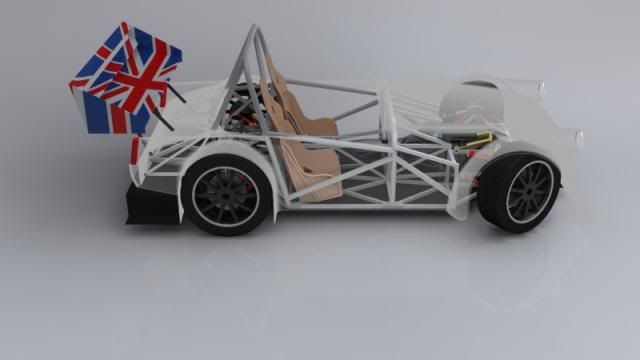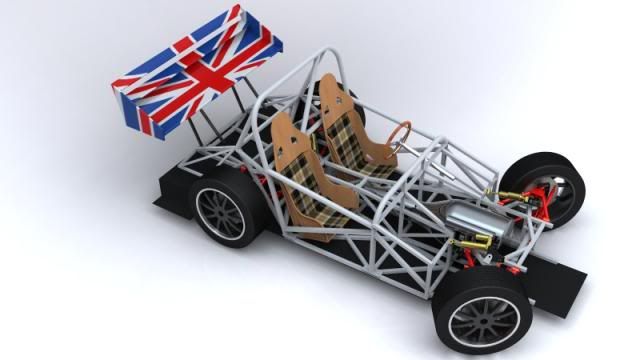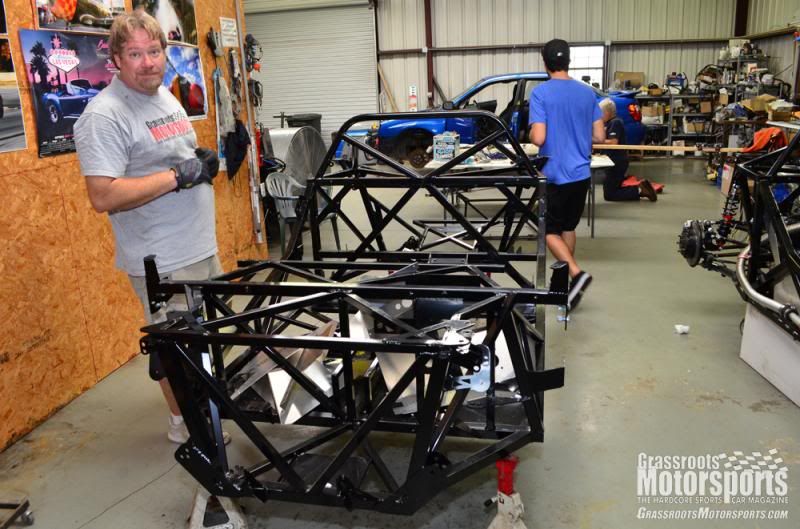Holy awesome post Nocones
nocones wrote:
My car building recipie goes like this:
1. determine what Drivetrain (Front, Mid, Rear engine, FWD, RWD, AWD) you are going to use.
2. Identify a power goal to select an engine and transmission.
3. Do a rough layout of key components to determine rough weight distribution targets (Include engine, trans, occupants, fuel tank and any other heavy items you know the weight of. Assume the chassis weight and that it's near 50/50 your just getting close here). Here is where you determine Track width (Driven by expected CG height), and Wheel base (Driven by desired Weight distribution).
I’d say his plan is fairly obviously Front/Rear. Also assuming this is fun road/track/toy I wouldn’t get too stuck on 50:50 weight distribution, surely anything from 40:60 to 60:40 is fine. Most ‘7’ end up with a rear weight bias anyway. I’d say his weight dist. is going to end up where it ends up depending on his donor parts and can be measure later and used for initial ride frequencies?
nocones wrote:
4. Select Tire sizes (Width, Overall Diameter, and Rim diameter) based on HP, Weight distribution, and drive configuration. You need to consider required brake system performance because it will drive your Rim diameter.
Again I’m going to swag that this is 90% determined by his donor, as in 90% of Miata based cars end up with off the shelf 15x6 or 15x7 wheels and 195-225 section tires as that’s what’s cheaply and easily available.
nocones wrote:
5. Suspension. Now things get interesting. It's time to design your suspension. No 1 solution works and there are NUMEROUS entire BOOKS about this so everything I say from here is VERY condensed from my experience the design of 4 competition vehicles. I always start at the front. Assuming you’re running a double A-arm or multilink type suspension the first choice I feel you should make is what your goal for Kingpin inclination and scrub radius is. This will determine the location of your lower ball joint and will be used to drive the rim offsets. Make sure you can get rims of the offset you want. I always design for close as possible to 0 KPI with minimal scrub radius. Next chose a camber coefficient that you want and a RC height. These two numbers basically coupled to the Lower Ball joint location dictate the path that your A-arms can lie on. The Camber coefficient determines your VSAL. This also dictates where your load paths into your chassis are. You now simply draw your front layout and determine the highest position possible for the Upper ball joint that will be dictated by your rim diameter. The only big things left are determining actual A-arm lengths (Fix the inner pivot locations) as well as select a Caster and spindle offset (Determine Trail). Relative A-arm lengths will have an impact on how much your roll center moves as the suspension travels and how much your VSAL changes. Determine how you are going to suspend the car (Push/Pull rods, bellcranks, direct action shocks). You also need to design the steering. That’s actually fairly easy. Select a Ackerman percentage determine where the Steering links go and their length (Driven by desired steering ratio and available steering rack ratios) and determine their locations on the car. The outer endlinks are determined by the ackerman ratio and can be at any height provided the inner pivots are at the correct location. Inner pivots should be on a line between the upper and lower inner A-arm pivot and create a line with the outers that intersects your static VSA. This determines your rack width and height. Generally you will have a fixed rack width so this will driver your rack height (Or space constraints will) and the Upright side will just be determined from this location.
Rear suspension thankfully is easier. It doesn’t turn so KPI/Caster/Scrub Radius are much less important. Basically you follow the recipie for the front otherwise but you need to consider avoiding drivetrain components and anything else that will get in your way. I run much shorter VSAL in the rear because you can’t gain camber through caster (usually around 1.2x track width).
Beautiful and concise way to put it, but for 99% of builders I doubt they go that far. I think most people, who even go this far, start with whatever front upright, wheel, tire etc. they are going to use then initial draw a parallel to the ground line as an LCA, then draw a line from the contact patch through their desired roll center (let’s say 2”) then draw an initial UCA that intersects the two lines, then mess about with camber gain by changing the UCA inner pivot along that line. Not perfect but workable and reasonably predictable for 90% of cases. What you outline is perfect for drawing up a pure race car, dedicated autocross car etc., but probably beyond the time and effort that 99% of people put in. As for steering again I bet most of the time people live with whatever Ackerman they get from their chosen uprights and WB, then just adjust the height to try and minimize bump steer, many just live with the rack length, others buy or modify to get a better rack length. For the rear what about a nice simple live axle either 3 or 4 link with a long panhard rod (I don’t see the real world point of a Watt’s if you’ve got a 3-4’ long PAnhard and only 3-4” of total vertical suspension movement. In a small light war with relatively high wheel rates this is going to give people a reasonably good car that’s limits are so far beyond most drivers and 99.99% of on road situations that you’d never notices the deficiencies inherent in their design. What’s ACBC’s famous quote ‘Any suspension design will work if you don’t let it’?
nocones wrote:
6. Finally the Chassis. You now know where everything goes (engine, trans, fuel tank, people) and where your road forces will act on the CG (Suspension design). You can finally design a chassis. Basically play connect the dots with straight lines, avoid things you can’t put lines through, make triangles and I like to include a SCCA/NASA legal Cage appropriate to the weight of the car I’m building. I figure I want to use my car in anger and these guys are who I would most likely be looking to do that with. If you’re going to build, build to some sanctioning body so you don’t have surprises later.
Notice how low on the list this is. I love making concept sketches of cars and chassis but I’ve done this 4 times and have a good idea of what a suspension will look like. It sounds like you are still very early in the game and are getting ahead of yourself.
After the chassis things get fun because you get to update your weight spreadsheet and start to determine spring rates, ride frequencies etc. Obviously the inclusion of OEM off the shelf components fix some of the dimensions and freedom you have. This is sometimes good because a true clean sheet design is Insanely time consuming and difficult. Saying I’m going to use a Miata upright or MG steering rack fixes some dimensions and makes your job easier.
Good luck and take things as constructive. Your primary goal should be to make something safe and have fun. It’s a crazy road your headed down so I wish you luck.
As I say Nocones, this is not in any way meant to disagree with anything you’ve written as a)I agree for a perfect situation and b) I’ve never designed a car myself. Well that’s not true, in my head I’ve designed 1,000,000’s, they just never get out of my head. I just wanted to step in and try not to frighten off the guy before he starts. I’d love you to start a thread on your thoughts for RC height, swing arm length, RC migration etc. for a variety of cars.
To the PO, just to cheer you up, this is a pic of the front suspension of a Dutton Phaeton kit car. Latterly thousands of these monstrosities were built in the 70’s and 80’s and people somehow survived with this dreadful mess of a front end without killing themselves.
 I’d say step #1. What is your realistic goal with this? To say you’ve built a car? To build something that looks cool, ‘feels’ quick and is great to drive down a twisty road on a sunny day? Build something that is fun to autocross once or twice a year? Build something to do a track day once or twice a year? Building something you can autocross or track every single weekend and happens to be just about legal enough to drive on the street. They all have very different requirements for the suspension, chassis, running gear etc.
I’d say step #1. What is your realistic goal with this? To say you’ve built a car? To build something that looks cool, ‘feels’ quick and is great to drive down a twisty road on a sunny day? Build something that is fun to autocross once or twice a year? Build something to do a track day once or twice a year? Building something you can autocross or track every single weekend and happens to be just about legal enough to drive on the street. They all have very different requirements for the suspension, chassis, running gear etc.




 But on a lower section of the vehicle like the Lotus Elan
But on a lower section of the vehicle like the Lotus Elan





































